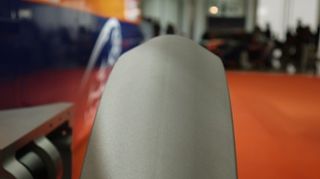Everything you need to know about the 1,000 mph Bloodhound SSC
The brainchild of F1 designers, aerospace engineers, and rocket scientists
The dry build in London

After eight years of research, design and manufacturing, the Bloodhound SSC was first shown to the public on September 24, in Canary Wharf. It's what is known as a dry build (essentially, making an Airfix kit without the glue), and is about 95 per cent of the finished article - some panels and systems were removed to allow the public to see into the vehicle.
What's striking about seeing the car in the metal is how big it is. At 13.5 m (44 ft) long and 3.0 m (9.8 ft) high it dominates the room, yet, at the same time it looks impossibly thin at only 2.5 m (8.2 ft).
The front section of the vehicle consists of a carbon fibre monocoque (single piece shell). It's crafted from multiple layers of carbon fibre, using F1 design expertise to produce the strongest safety cell ever fitted to a racing car.
Moving back, the fuselage that holds the three engines is made from aircraft-grade banded aluminium. This shape is aerodynamically optimised to reduce drag, while increasing downforce and yaw stability (ie: preventing it weaving about like a roller skater on ice).
The wheels are another interesting feature. Made from cast aluminium with a smooth tread, they measure 36 inches in diameter, and will rotate up to 10,200 rpm during the record attempt.

The Bloodhound's cockpit features a timing clock and a rolex-made speedometer which can register up to 1,100 mph. Three anti-glare screens relay information to Andy while he's driving, and there's also an HD camera, a radio, and a bank of buttons and switches.
The cockpit contains two computers (one acts as a backup), that power the screens in front of Green, but they're not as powerful as you might think, with the most intensive work being the gathering of data from the 500+ sensors on board and processing it.
Get daily insight, inspiration and deals in your inbox
Get the hottest deals available in your inbox plus news, reviews, opinion, analysis and more from the TechRadar team.
Most parts are off-the-shelf components where possible. This both improves reliability and makes replacements easier.

Where next?
After the Bloodhound SSC has finished receiving admiring glances from the public at Canary Wharf, it will be taken back to Bristol and dismantled again.
Assuming everything goes to plan, the car will begin (comparatively) low-speed testing towards the end of this year on the runway at Newquay Cornwall Airport. This will involve using just the jet engine to reach speeds of around 200 mph (320 kmh), and will allow the engineers to sign off on the electrical and software control systems.
After that, it's over to South Africa and the lake bed of Hakskeen Pan, with the aim being to commence high-speed testing mid-2016.
Current page: The Public Debut and onto bigger things
Prev Page Introduction Next Page The Record Attempt, Cost and The Education Project